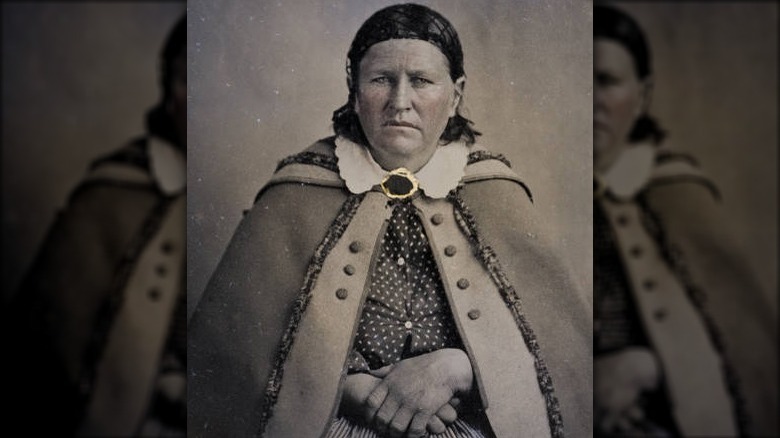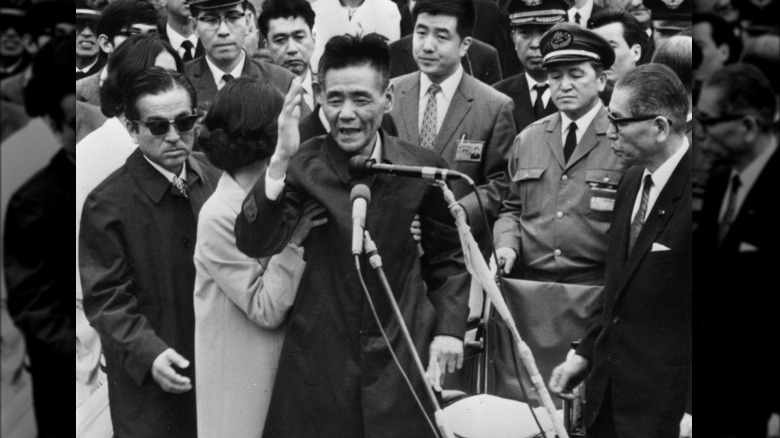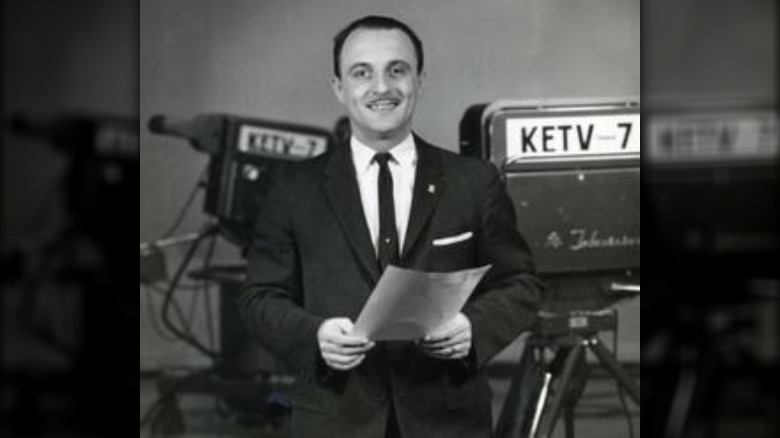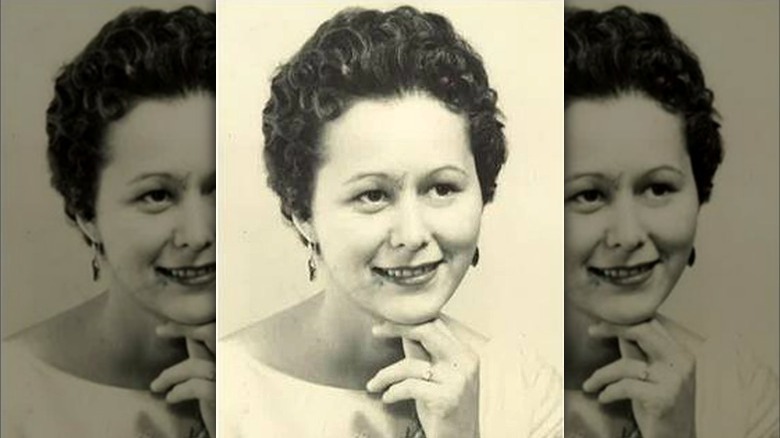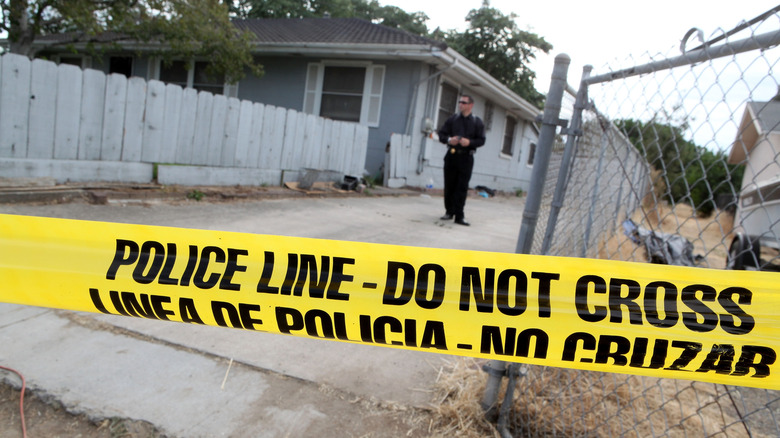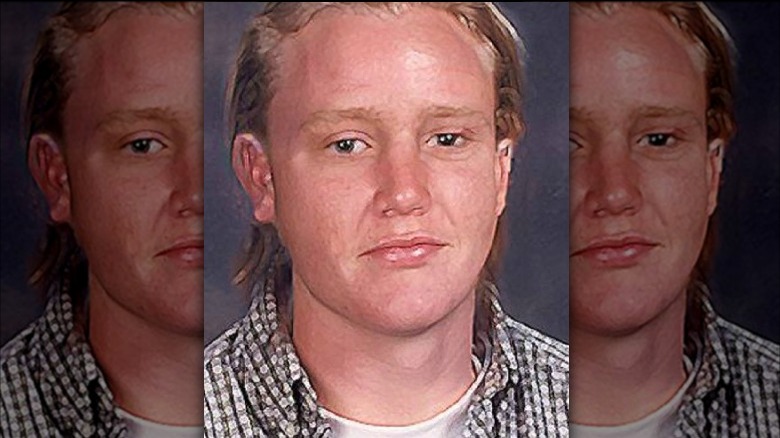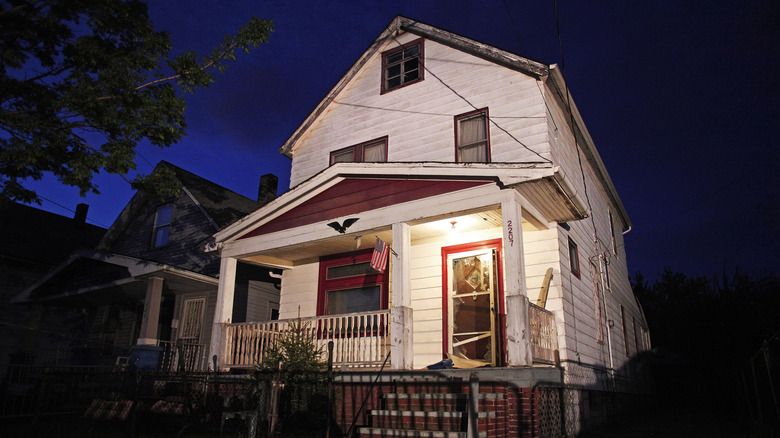People Who Went Missing And Were Found Years Later
The National Crime Information Center (NCIC) has been keeping records on missing persons since 1975, but people have been going missing since the beginning of time. In 1021, Abu Ali Mansur — ruler of the Fatimid dynasty — rode into the hills near Cairo and was never seen again. Searchers found only his donkey and bloodstained clothing (via the Institute of Ismaili Studies). Then, 462 years later, the boy king Edward V and his brother Richard vanished from their prison in the Tower of London, and a couple of hundred years after that two skeletons of matching ages were found buried at the foot of a staircase (via Historic UK). Missing kings are remembered, but across many centuries of human history, there have also been countless common people who went missing and were forgotten.
Today we have better resources, and the FBI never forgets. In early 2021, the NCIC announced it had just under 90,000 active missing persons cases (via FBI). This is actually a fraction of the number of files it opened that year (around 543,000), because most new files are almost immediately canceled. Missing persons, after all, aren't always really missing. Some are kids who wander off and are later found, others are adults who take off for a couple of days without telling anyone where they're going. But a few cases stay open, sometimes for years. Some turn into homicides, some are never solved, and a rare few are solved years later when the missing person turns up alive.
Alexander Selkirk
Alexander Selkirk is one of history's most famous missing persons, but there's a good chance you don't recognize his name. That's because his story became famous only after it was fictionalized and he was rebranded "Robinson Crusoe."
According to Smithsonian, Selkirk was really only sort-of missing. There were plenty of people who knew where he was, notably the 21-year-old ship captain who deliberately stranded him on an island 418 miles off the coast of Chile. At first, Selkirk was all, "Cool, just leave me here. I don't like you and I don't want to be on your leaky ship." (Note: not an actual historical quote). When Selkirk realized no one else was going to join him on his 3-hour tour, though, he begged the captain to reconsider. And because 21-year-olds who have too much responsibility aren't exactly known for their empathy, the captain rather predictably refused to take him back.
The ship sailed away and Selkirk was left to fend for himself for four years and four months. Fortunately, the island was populated by feral animals, so he survived on a well-balanced diet of seafood, goats, watercress, and turnips. When he was finally picked up by a passing ship, his rescuers noted that he was so wild in appearance and mannerisms that he seemed to have "forgot his language for want of use, we could scarce understand him, for he seem'd to speak his words by halves."
Cynthia Ann Parker
By the early to mid-1800s, European occupation was taking a toll on native villages. As their populations fell, some indigenous people turned to kidnapping as a way to increase their numbers. Sometimes, kidnapped white children were adopted by indigenous families who had lost their own children to diseases like cholera or smallpox (via HistoryNet). One of these children was Cynthia Ann Parker, who was abducted from her family farm in Texas when she was just nine years old (via Humanities Texas).
Parker was missing for 24 years, though there were occasional sightings of her living among the Comanche. She eventually married and had three children, and probably would have stayed with the Comanche until her death, except some Texas Rangers decided to "rescue" her and her infant daughter. Her reunion with her white family was not a happy one, and Parker never adjusted to life in the white settlements. Despite being a grown woman capable of making her own choices, she was also not permitted to return to the Comanche and her two sons, one of whom — Quanah Parker — became one of the most influential Comanche leaders in history.
There are some conflicting accounts about her eventual death sometime between 1864 and 1871. According to Texas Monthly, she is said to have starved herself to death.
Shoichi Yokoi
World War II ended in 1945 ... for most people. While Allied soldiers and probably more than a few Germans were celebrating the end of the war, thousands of Japanese soldiers who'd been given strict orders to "never surrender" were wondering what to do next. According to Smithsonian, 5,000 Japanese soldiers retreated into the jungle after the Japanese lost the Battle of Guam in 1944, because eating rats and frogs for breakfast, lunch, and dinner was seen as far more noble than becoming a prisoner of war.
Most of the holdouts were captured or killed within a few months, but there were a few who stayed hidden. Then the war ended, families back in Japan waited and wondered about the fate of their loved ones, and the holdouts on Guam kept on eating rats and frogs. One of these was Shoichi Yokoi, who lived in the jungle with nine or 10 other soldiers. Over the years, Yokoi's companions either died or surrendered and by 1964 he was the only one left. Still, he continued to live alone in the jungle until 1972, when a pair of local fishermen encountered him checking a fish trap on the Talofofo River. A scuffle ensued and Yokoi was overpowered, captured, and repatriated back to Japan. Even so, he was not exactly relieved that his long ordeal was over. "It is with much embarrassment that I return," he declared upon seeing his homeland for the first time in more than 30 years.
Lawrence Joseph Bader
Admit it, the idea of faking your own death has occurred to you at least once. Most of us can't just call Best Quality Vacuum and ask for a Hoover MaxExtract PressurePro model 60 dust filter, though, so we just endure life as ourselves and hope for better times. Not Lawrence Joseph Bader. This guy faked his own death and got away with it for eight years.
According to Mental Floss, Bader was having some financial problems, including lots of bills and a wife who was pregnant with their fourth child. On an evening in 1957, he paid the premium on his life insurance policy, packed a suitcase, and rented a boat even though the proprietor told him there was a dangerous storm on the way. The next day, the empty boat was found washed up on shore, with no sign of Bader or his suitcase.
Eight years later, Bader's niece encountered a man at a sporting goods convention who looked exactly like her uncle. Fingerprints later confirmed that the man, who was now going by the name Fritz Johnson, was indeed Lawrence Bader. It sure does seem like Bader knew what he was doing, but he continued to deny any knowledge of his previous life and went to his grave still claiming to be Fritz Johnson. They even had two funerals for him — one to satisfy his new family, and the second to bury him under the name he was born with.
Lucy Ann Johnson
In 1961, Lucy Ann Johnson vanished, leaving her 7-year-old daughter Linda and an 8-year-old son without a mother (via Global News). The missing person report wasn't filed until three years later, which kind of raises some red flags, and police immediately suspected foul play. They even tore up the family's backyard in search of Johnson's body but found nothing.
In 2013, Johnson's now-adult daughter put her mother's photo in northern British Columbia and Yukon newspapers, where she believed Johnson had ties. According to CBC, someone recognized the photo — Johnson's other daughter, who'd been born after her mother's disappearance. The family reunited, and Linda learned that Johnson hadn't really been missing at all, at least not in the conventional sense. She'd simply fled an unhappy marriage — in fact, her husband had essentially kicked her out.
Weirdly, Johnson remarried but otherwise didn't invent a new identity for herself, which does kind of say something about how hard the police tried to find her (they didn't). She later told Linda that she'd gone back for her children, but her husband refused to give them up. The couple parted and for some reason, it never occurred to Lucy to stay in touch, and it didn't occur to her husband to tell the police or his kids that Lucy was in the Yukon. Or maybe he did, and they just didn't believe him.
Petra Pazsitka
In 1984, a 24-year-old college student from Braunschweig, Germany, went to the dentist and never returned. Just in case that's just giving you new reasons to be irrationally afraid of dental work, Petra Pazsitka didn't die in a root canal gone wrong, she just never came home.
As is often the case when a young woman disappears, police suspected murder. A massive search ensued, and Pazsitka was even featured on the German true-crime show "Aktenzeichen XY." For a while there was a suspect — in 1987, a man identified only as Gunter K. said he'd killed Pazsitka (via The Telegraph), and since he'd also confessed to killing a 14-year-old girl in the same part of Germany, police had no reason to disbelieve him. He later withdrew his confession (via Independent), which didn't necessarily mean he wasn't the killer.
Pazsitka was declared dead in 1989, and that was that — until 2015, when a woman in Dusseldorf named "Mrs. Scheider" called police to say her apartment had been burgled (via News.com.au). When unable to produce ID, she confessed to being the missing woman. Evidently, she'd managed to evade discovery by never opening a bank account or attempting to get a driver's license or social security card. She also couldn't be charged with a crime, because she'd never tried to use false documents. The reasons for Pazsitka's disappearance are still not clear. She told police she was neither interested in discussing the matter publicly nor reuniting with her family.
Edgar Latulip
In Hollywood, people get amnesia all the time. In fact, people get amnesia so often on television and in the movies that it seems like it ought to be declared a public health emergency — except that Hollywood is almost never a reflection of reality. According to Medical News Today, amnesia is actually "very rare," so the chances that you'll suddenly remember you're the heir to an oil fortune are, sadly, vanishingly slim.
That doesn't mean amnesia doesn't ever happen, though. According to the Washington Post, Edgar Latulip had "developmental delays" and "mental health challenges" and was off his medication when he disappeared in 1986. His family did know that he was headed for Niagara Falls, and since people often go to Niagara Falls to end their own lives, they feared the worst.
The only injury Latulip was known to have suffered, however, was a head injury, which evidently was bad enough to cause a bona fide, Hollywood-style case of amnesia. With nowhere to go and no family to call, he ended up settling in the Niagara region under an invented identity (via the Guardian). Then, 30 years later, while living in a group home, he suddenly remembered his real name. With the help of a social worker, Latulip discovered that he was a missing person. His identity was later confirmed through DNA.
Jaycee Dugard
When adolescent girls are abducted by strangers, there's almost never a happy ending. Most of the time they turn up dead, if they turn up at all. When 11-year-old Jaycee Dugard disappeared while walking to the bus stop, police feared the worst, and they didn't get any more hopeful when days turned into weeks, then into years.
But Dugard was alive and living in a shed in Phillip and Nancy Garrido's backyard in Antioch, California (via Biography). For 18 years, she was kept prisoner by the Garridos, who told her that her family didn't love her and wasn't looking for her. While in captivity she gave birth to two of Phillip Garrido's children and eventually gave up hope of escaping.
Then, Garrido got cocky. He brought Dugard's two daughters with him to see the special events coordinator at the UC Berkeley campus, where he was hoping to stage a religious event of some kind. The special events manager thought something was off about Garrido and the girls and called his parole officer, and after that everything started to unravel for the Garridos. Dugard revealed her identity during a parole meeting and her long ordeal was over.
Dugard was reunited with her family in 2009. Her family got a $20 million award from the State of California as an acknowledgment that Garrido's parole supervision had maybe not been as thorough as it should have been.
Chioma Gray
Sometimes abducted kids don't know they've been abducted. That's true when an estranged parent abducts a child they don't have custody of, and it's sometimes also true when a teenager is abducted by the adult who's been grooming her. According to the Ventura County Star, this is what happened to Chioma Gray, who disappeared in 2007 at the age of 15. Her abductor was 20-year-old Andrew Joshua Tafoya, who took her to Mexico, where they were married.
A private investigator located Tafoya and Gray in Mexico after discovering the stolen car they'd been driving in a compound near Acapulco. He later found them living nearby and working in a small resort. It's not super clear if the private investigator prompted Gray's return or if Gray decided on her own that she wanted to go home, but in 2011 she was finally reunited with her family in Ventura, California.
According to the Ventura County Star, in 2012 Tafoya plead guilty to felony charges of concealing a child from her parents and was sentenced to two years in jail. Gray's happy reunion with her family was short-lived, however — she later moved in with Tafoya's parents and at Tafoya's sentencing hearing called him her husband and asked the judge for leniency. Her parents attributed her support of her abductor to Stockholm syndrome. The news lost track of the story after that, so it's not clear what became of the pair when Tafoya was released from jail, which presumably happened in 2014.
Timothy Carney
Sometimes people get abducted, sometimes they're murdered, sometimes they have amnesia, and sometimes they join weird churches and are never heard from again. That's what appears to have happened to Timothy Carney, who vanished in 2004 after telling his employer he'd be late to work. His car was later found abandoned, which seemed to confirm that something sinister had happened to the 25-year-old. Carney's distraught family rented billboards to plead for his safe return, but no one ever called to report his whereabouts and the case went cold.
Then, almost 7 years later, Carney's family was informed that their son's missing person's case had been cleared from the national database (via Tri-Boro Patch). The reason: he'd been located. But that was only a small comfort to his parents, who weren't told where he was or offered a reunion because Carney was evidently not interested in revealing his location.
No one is really sure what Carney's deal was, but his parents think he was influenced by the Gospel Outreach, a local church that Cult Education Institute says has been accused of cult-like behavior. Carney's parents initially said they believed he disappeared mostly to escape the controlling influence of the church, but they've also said it's possible the church may have been directly involved in their son's disappearance and refusal to make contact with his family.
Marx Panama Barnes
The majority of modern adoptions are done through legitimate channels, but occasionally a child's origins are a mystery. This seems to have been the case for 35-year-old Steve Carter, who was adopted at the age of four. His parents were loving and his family life was happy, but as he grew, he discovered some strange details about his past. His birth certificate, for example, seemed sort of off. It was issued almost a year after his birth, and it described him as half-Hawaiian, even though he was blonde and blue-eyed (via CBS News). In 2011, Carter decided to check the National Center for Missing and Exploited Children. On the website, he found an age-progression image of someone named Marx Panama Barnes and immediately recognized himself (via CNN).
It wasn't just a hunch — DNA testing later confirmed that Carter was really Barnes, who had been missing since his biological mother took him for a walk and never returned. Details are a bit foggy after that, but Carter thinks his mother left him in a Hawaiian orphanage before vanishing herself. It's not clear why the birth certificate wasn't right, but it does seem likely that Carter's biological mother was either not completely honest or simply left him on a doorstep, which might explain why the orphanage didn't have the right documentation.
The last time this story was in the news, Carter had yet to meet his biological family in person, but said he'd contacted them via telephone.
Carlos Sanchez Ortiz
Burnout affects us all, from the lowliest CEO to the hardest-working waitress. People deal with burnout in a lot of different ways — some take a few months off, some change careers, and others just endure. For Spanish physician Carlos Sanchez Ortiz, burnout meant leaving everything he knew and wandering off into the woods. Sanchez was suffering from depression when he disappeared in 1996, just after receiving his medical degree. In 2010, he was declared dead.
According to the Local, two mushroom pickers foraging in a national park near the coast of Tuscany, Italy encountered a man with a long beard and a dirty face whose faded, expired passport identified him as Carlos Sanchez Ortiz. Sanchez told the mushroom pickers and a park ranger that he was there because he didn't want to live around people, and now he would have to move because his camp had been discovered.
After the encounter, authorities located Sanchez's parents, who traveled to Tuscany to look for their son but found only the place where his shelter had once been. Undeterred, his parents said they would keep looking, but were mostly just happy to know their son was alive. "We respect his will and his freedom but we're not leaving until we have held him in our arms again — even if it is just for one last time," his mother told reporters. Because these stories always drop out of the news too soon, though, it isn't clear if the reunion ever happened.
Amanda Berry, Michelle Knight, and Gina DeJesus
School bus driver Ariel Castro's home in Cleveland was run down and creepy — so creepy his neighbors even called the cops a couple of times. One heard pounding on the doors; on another occasion, a neighborhood kid thought she saw a naked woman crawling around in the backyard. The cops made a couple of half-hearted attempts to find out what was happening inside, but they never actually entered the house, which frankly makes it kind of tough to ... find out what's happening inside (via CBS News).
If they had breached the threshold, police would have discovered Castro's three prisoners: Amanda Berry, Michelle Knight, and Gina DeJesus. Castro abducted the women in 2002, 2003, and 2004 and kept them chained up and half-starved inside a blacked-out room (via Evening Standard). One of them — Berry — gave birth to his child in 2006.
One day in 2013, Castro slipped up and left a door unlocked, but when Berry tried to escape she encountered a screen door that was locked from the outside. Screaming for help, Berry kicked out the bottom of the door, crawled through, and escaped with her daughter to a neighbor's house (via NPR). Police returned to the home to rescue the other two women and were able to arrest Castro when he returned (via People). He was later sentenced to life in prison plus 1,000 years. After serving a tiny fraction of his sentence, Castro died by suicide in his prison cell.
William Burgess Powell
In 2004, a Burger King employee discovered a naked man covered in fire ants sleeping next to one of the restaurant's dumpsters in Richmond Hill, Georgia. The police were called, and the stranger was transferred to a hospital. He was lucid but unable to recall his name, so he was entered into hospital records as "Burger King Doe." According to the New Republic, B.K. Doe could only remember a few things about his life. He had three brothers. His birthday was August 29, 1948. And he thought he remembered being in Denver.
Years went by. B.K. Doe adopted the name Benjaman Kyle and got some help from friends determined to figure out his identity. At one point, he was even featured on the FBI's missing person's page — it was the first time the Bureau ever listed a missing person whose location was known. Kyle appeared on "Dr. Phil," too, but none of the episode's 4 million viewers were able to identify him.
Then in 2016, a genealogist was finally able to match a name to the person: William Burgess Powell, who disappeared from his home in Lafayette, Indiana in 1976. The name, though, only solved part of the mystery. From 1983 until his appearance at Burger King, there's no record of what Powell was doing or where he was living. And today, even with his identity restored and a brand new social security card in his wallet, Powell still can't recall any of those missing years.


